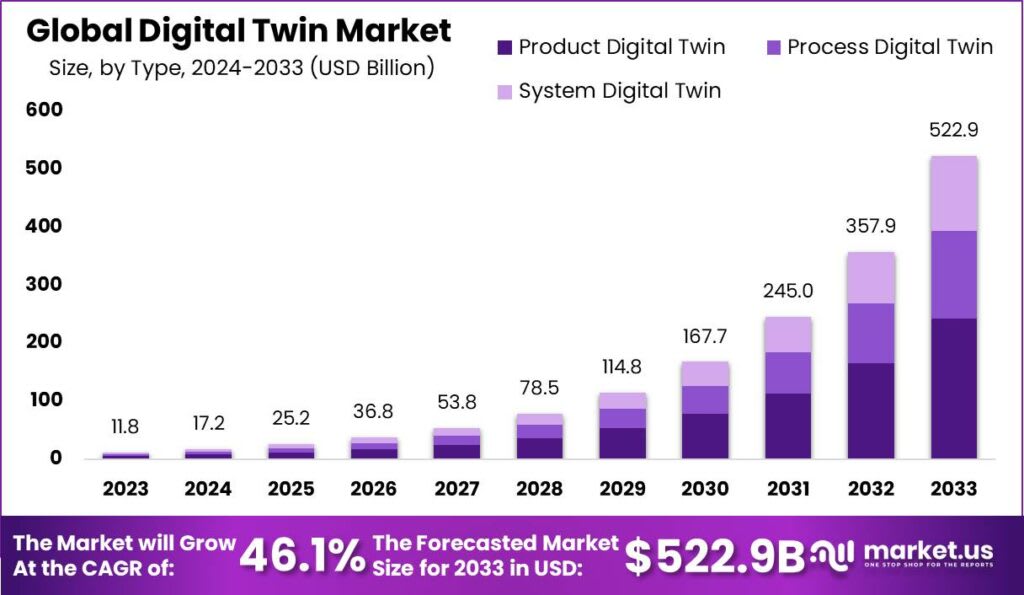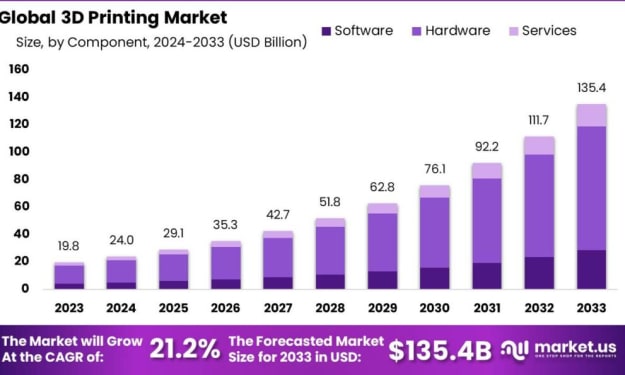"Digital Twin Market: Transforming Industries with Virtual Simulations"
"Digital Twin Market: Pioneering Digital Replicas for Real-World Impact"

Introduction:
The Global Digital Twin Market size is expected to be worth around USD 522.9 Billion by 2033, from USD 11.8 Billion in 2023, growing at a CAGR of 46.1% during the forecast period from 2024 to 2033.
Read More - https://market.us/report/digital-twin-market/
Key growth factors include increasing adoption across industries like manufacturing, healthcare, and transportation for predictive maintenance, operational efficiency, and product innovation.
However, challenges such as data privacy concerns and high implementation costs can hinder market expansion. New entrants can capitalize on the rising demand for customized Digital Twin solutions tailored to specific industry needs.
Emerging Trends:
AI Integration: AI algorithms are enhancing the predictive capabilities of Digital Twins.
Edge Computing: Edge-based Digital Twins are reducing latency and enhancing real-time analytics.
Blockchain Security: Blockchain is being explored to secure Digital Twin data and transactions.
AR/VR Integration: Augmented and Virtual Reality are improving visualization and simulation capabilities.
Digital Twin Consortia: Collaborative efforts are forming to standardize Digital Twin development and interoperability.
Top Use Cases:
Manufacturing: Optimizing production processes and reducing downtime.
Healthcare: Personalizing patient care through virtual models of organs and systems.
Smart Cities: Enhancing urban planning and infrastructure management.
Automotive: Improving vehicle design, performance monitoring, and autonomous driving.
Energy: Predicting equipment failures and optimizing energy consumption.
Major Challenges:
Data Privacy: Concerns over the security and ownership of sensitive IoT data.
Integration Complexity: Connecting diverse systems and ensuring interoperability.
Cost of Implementation: High upfront costs for infrastructure and technology adoption.
Skill Shortages: Shortage of skilled professionals capable of managing Digital Twin ecosystems.
Regulatory Compliance: Adhering to industry-specific regulations and standards.
Market Opportunity:
Industry 4.0 Adoption: Increasing adoption of Industry 4.0 practices driving demand.
IoT Expansion: Growing IoT ecosystem providing data for Digital Twin development.
Healthcare Digitization: Rising demand for personalized healthcare solutions.
Smart Infrastructure: Investments in smart cities and sustainable infrastructure projects.
Digital Transformation: Companies prioritizing digital strategies for operational efficiency.
Conclusion:
In conclusion, the Digital Twin market presents significant opportunities for innovation and efficiency across various sectors despite challenges such as data security and integration complexity.
Emerging trends like AI integration and AR/VR advancements are reshaping the landscape, while use cases in manufacturing, healthcare, and smart cities demonstrate the versatility and potential impact of Digital Twins.
New entrants can leverage these trends and opportunities to carve out niche solutions and drive future growth in this dynamic market.
About the Creator
Enjoyed the story? Support the Creator.
Subscribe for free to receive all their stories in your feed. You could also pledge your support or give them a one-off tip, letting them know you appreciate their work.





Comments
There are no comments for this story
Be the first to respond and start the conversation.